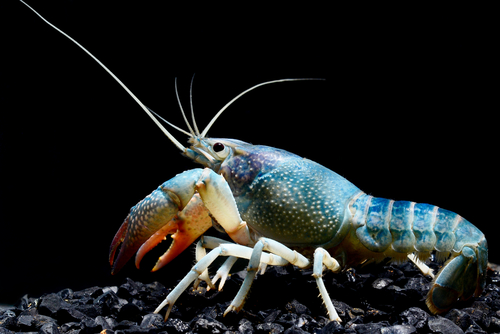Crayfish are fascinating creatures that make great pets. They are hardy, easy to care for, and have unique personalities. However, many new crayfish owners struggle with what to feed their pets.
Understanding what crayfish eat is essential to keeping them healthy and happy.
In their natural habitat, crayfish are omnivores and will eat almost anything they can find. They feed on a variety of plants, insects, snails, and even small fish.
However, in captivity, their diet needs to be carefully monitored to ensure they receive all the necessary nutrients.
Contents
Key Takeaways on What Do Crayfish Eat as a Pet?
- Crayfish are omnivores and will eat almost anything in their natural habitat.
- In captivity, their diet needs to be carefully monitored to ensure they receive all the necessary nutrients.
- A balanced diet for pet crayfish can include a variety of commercial foods, fresh vegetables, and protein sources.
Check out these other top picks in this category:
Understanding Crayfish as Pets
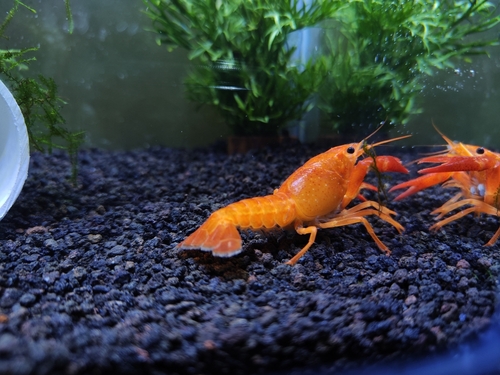
Crayfish, also known as mudbugs, crawdads, or freshwater lobsters, are crustaceans that are often kept as pets. These freshwater crustaceans are native to North America and can make great pets for those who understand their needs.
Pet crayfish require a freshwater aquarium with plenty of hiding places, such as rocks, plants, and caves. They are also territorial and may become aggressive towards other crayfish or fish in the tank, so it’s important to provide enough space for each crayfish.
When it comes to feeding, crayfish are omnivores and will eat a variety of foods. A balanced diet for a pet crayfish includes both animal and plant matter. Some common foods for pet crayfish include:
- Pellets or flakes designed for freshwater crustaceans
- Algae wafers
- Freeze-dried or frozen shrimp
- Vegetables such as spinach, zucchini, and peas
- Live or frozen brine shrimp or bloodworms
It’s important not to overfeed pet crayfish, as they can become obese and develop health problems. A general rule of thumb is to feed them only what they can eat in a few minutes, once or twice a day.
In addition to a balanced diet, pet crayfish also require clean water and regular tank maintenance. Crayfish produce waste that can quickly pollute the water, so it’s important to regularly change the water and clean the tank.
Crayfish in Their Natural Habitat
Crayfish are freshwater crustaceans found in a variety of habitats, including streams, rivers, ponds, and lakes. In the wild, crayfish are omnivorous, which means they eat both plants and animals.
Crayfish feed on a variety of aquatic plants, including grasses, algae, and other vegetation. They also eat decaying vegetation and weeds. Crayfish are opportunistic feeders, which means they will eat whatever is available to them.
In addition to plants, crayfish also feed on a variety of small animals, including insects, snails, and other crustaceans. They are also known to eat fish and amphibians, although this is less common.
Crayfish are most active at night and are often found scavenging for food in the dark. They are also known to burrow into the mud or sand to find food, using their powerful claws to dig and search for prey.
Crayfish Diet in the Wild
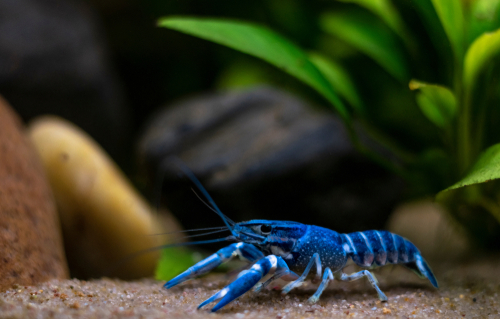
Crayfish are omnivorous creatures that eat a variety of food in the wild. They feed on a wide range of organic matter, including algae, worms, insects, small fish, snails, plankton, larvae, mosquito larvae, dead fish, and dead animals.
Algae is a significant part of the crayfish’s diet. It is a primary source of food for young crayfish, and it provides essential nutrients for adult crayfish. They also eat aquatic plants such as water lilies, duckweed, and water hyacinth.
Insects and their larvae are also a crucial part of the crayfish’s diet. They feed on aquatic insects, including mayflies, caddisflies, and dragonflies. The crayfish also eat the larvae of these insects, which are abundant in freshwater ecosystems.
Small fish and snails are also on the menu for crayfish. They feed on small fish such as minnows, and they also eat snails, which are a significant source of calcium for them.
Plankton and mosquito larvae are also a part of the crayfish’s diet. They feed on microscopic plankton, which is abundant in freshwater ecosystems. They also eat mosquito larvae, which are a common food source for many aquatic animals.
Finally, crayfish are known to scavenge for food. They feed on dead fish and animals, which are an excellent source of protein for them.
Feeding Your Pet Crayfish
Crayfish are omnivores, which means they eat both plants and animals. In the wild, they consume a variety of foods, including insects, small fish, snails, and plants. As pets, crayfish require a balanced diet to thrive.
When feeding crayfish, it is important to provide a mix of protein and vegetables. A diet that is too high in protein can lead to health problems, such as obesity and digestive issues. On the other hand, a diet that is too low in protein can cause malnutrition.
Some common foods that crayfish eat include shrimp, krill, bloodworms, and small pieces of meat. Vegetables such as carrots, peas, zucchini, lettuce, spinach, and green beans can also be added to their diet. Fruits like apples and bananas can be given as occasional treats.
It is important to note that crayfish are scavengers and will eat almost anything they come across, including dead fish and other crayfish. Therefore, it is important to keep their tank clean and free of any decaying matter.
When feeding crayfish, it is recommended to provide small amounts of food multiple times a day rather than one large meal. This will help prevent overeating and ensure that they receive a balanced diet.
Commercial and Specialized Foods for Crayfish
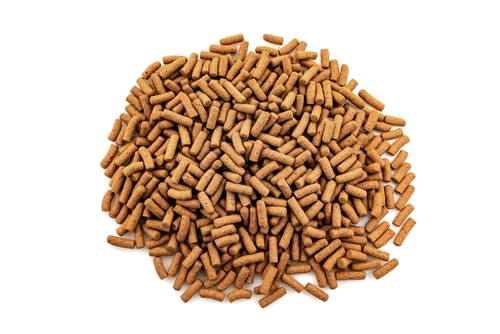
Crayfish are omnivores, which means they eat both plant and animal matter. In the wild, they feed on algae, aquatic plants, insects, and small fish. As pets, it is important to provide them with a balanced diet to keep them healthy and happy.
There are several commercial and specialized foods available in the market that are specifically designed for crayfish. These foods are formulated to meet the nutritional needs of crayfish and provide them with the necessary vitamins and minerals.
1. Algae Wafers
Algae wafers are a popular food choice for crayfish. These wafers are made from dried algae and are rich in protein, fiber, and vitamins.
They sink to the bottom of the tank, making them easy for crayfish to find and eat. Algae wafers are also suitable for other bottom-dwelling fish and invertebrates.
2. Shrimp Pellets
Shrimp pellets are another popular food choice for crayfish. These pellets are made from dried shrimp and are high in protein and other essential nutrients.
They sink to the bottom of the tank, making them easy for crayfish to find and eat. Shrimp pellets are also suitable for other bottom-dwelling fish and invertebrates.
3. Sinking Pellets
Sinking pellets are a type of fish food that is designed to sink to the bottom of the tank. They are available in a variety of sizes and formulas, including those that are specifically designed for crayfish.
Sinking pellets are a good source of protein and other essential nutrients.
4. Frozen Peas
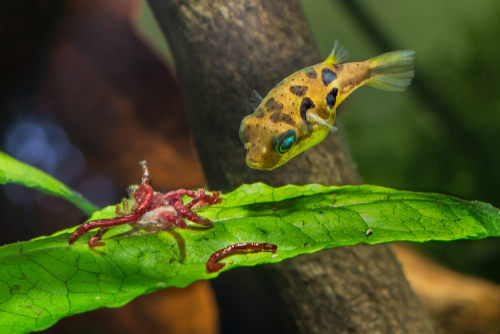
Frozen peas are a popular food choice for crayfish. They are high in fiber and other essential nutrients and are easy to prepare.
Simply thaw the peas and remove the outer skin before feeding them to your crayfish. Frozen peas are also suitable for other herbivorous fish and invertebrates.
5. Frozen Foods
Frozen foods, such as bloodworms, brine shrimp, and daphnia, are also suitable for crayfish.
These foods are high in protein and other essential nutrients and are available in most pet stores. Frozen foods are a good source of variety in the diet of crayfish.
6. Plant Foods
Crayfish also need plant-based foods in their diet. Fresh or frozen vegetables, such as spinach, kale, and zucchini, are a good source of fiber and other essential nutrients.
You can also feed them algae or aquatic plants, such as java moss or anacharis.
7. Commercial Foods
There are several commercial foods available in the market that are specifically designed for crayfish.
These foods are formulated to meet the nutritional needs of crayfish and provide them with the necessary vitamins and minerals. Some of the popular brands include Hikari Crab Cuisine, Omega One Shrimp Pellets, and Fluval Bug Bites.
Crayfish and Their Tank Environment
Crayfish are fascinating creatures to keep as pets, but they require a specific tank environment to thrive. Here are some important factors to consider when setting up a crayfish tank.
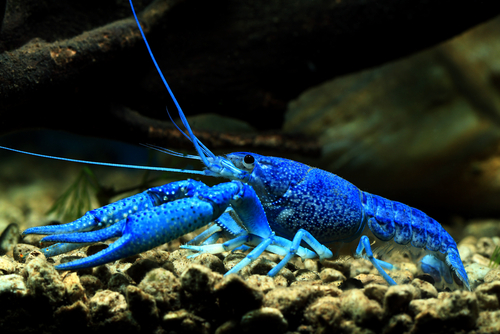
Tank
The size of the tank will depend on the number and size of crayfish you plan to keep. A general rule of thumb is to have at least 10 gallons of water per crayfish. The tank should have a secure lid to prevent escape, as crayfish are known to climb out of their tanks.
Fish Tank
Crayfish should not be kept in a fish tank with other fish, as they are known to be aggressive towards them. They may also eat smaller fish. It is best to keep crayfish in a tank by themselves.
Aquarium
The aquarium should be well-filtered to maintain water quality and prevent the buildup of waste. Crayfish are sensitive to poor water quality and can become stressed or sick if the water is not properly maintained.
Substrate
The substrate should be large enough for the crayfish to burrow in, but not small enough to be ingested. Sand or gravel are good options. It is important to avoid sharp or rough substrates that can injure the crayfish.
Java Moss and Hornwort
Crayfish enjoy hiding places, and java moss and hornwort are great options for aquarium plants to provide cover. These plants also help to maintain water quality by absorbing excess nutrients.
Health and Growth of Crayfish

Crayfish are hardy creatures and can thrive in a variety of environments. However, it is important to ensure that they are provided with the right conditions to maintain their health and promote growth.
Health
To ensure the health of your crayfish, it is important to provide them with clean water and a balanced diet. Crayfish are prone to bacterial and fungal infections, so it is important to maintain good water quality to prevent these issues.
It is also recommended to quarantine any new crayfish before introducing them to an established tank to prevent the spread of disease.
Growth
Crayfish grow rapidly and can double in size within a few months. To promote growth, it is important to provide them with a varied and nutritious diet.
Crayfish are omnivores and will eat a variety of foods including vegetables, fruits, and protein sources such as shrimp or fish. It is important to avoid overfeeding, as excess food can lead to poor water quality and health issues.
Molting
Crayfish molt regularly as they grow. During this process, they shed their old exoskeleton and grow a new one. Molting can be a stressful time for crayfish, and they may hide or become inactive during this period.
It is important to provide them with a safe and secure environment during molting to prevent injury or stress.
Minerals
Crayfish require minerals such as calcium to maintain a healthy exoskeleton. It is important to provide them with a source of calcium, such as cuttlebone or crushed eggshells, to ensure their health and growth.
Crayfish Behavior and Characteristics
Crayfish are fascinating creatures with unique behaviors and characteristics. They are omnivores, which means they eat both plants and animals.
In the wild, they eat a variety of foods, including insects, small fish, snails, and plants. As pets, they can be fed a diet of commercial pellets, vegetables, and proteins such as shrimp or fish.
Crayfish are also known for being nocturnal, which means they are most active at night. During the day, they tend to hide in their burrows or under rocks. They are also territorial and can become aggressive towards other crayfish in their tank.
One interesting behavior of crayfish is their cannibalistic tendencies. They will sometimes eat other crayfish, especially if they are smaller or weaker. To prevent this, it is important to provide enough hiding places and space for each crayfish in the tank.
Crayfish are also scavengers and will eat anything they can find on the bottom of the tank. This includes uneaten food, dead plants, and even dead fish. It is important to keep the tank clean and remove any uneaten food to prevent water quality issues.
Choosing Tank Mates for Your Crayfish
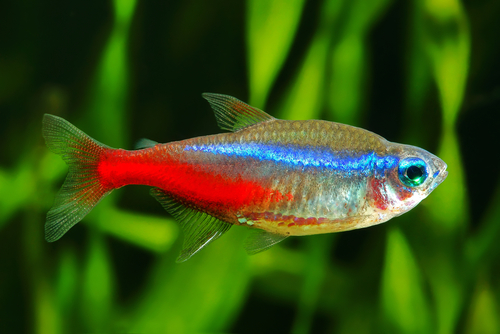
When it comes to choosing tank mates for your crayfish, it’s important to keep a few things in mind. While crayfish can coexist with some fish species, they can also be aggressive towards others.
Additionally, it’s important to consider the size of your tank and the needs of your crayfish and potential tank mates.
One thing to keep in mind is that crayfish are natural predators and can be aggressive towards other creatures in the tank. As a result, it’s best to avoid keeping small or slow-moving fish with your crayfish.
Instead, consider larger, more active fish species that can hold their own against the crayfish.
Some good tank mate options for crayfish include larger freshwater fish such as cichlids, danios, and gouramis. These fish are generally fast-moving and can avoid the crayfish when necessary. Additionally, they are less likely to be attacked by the crayfish due to their size.
It’s also important to consider the needs of your crayfish when choosing tank mates. For example, some crayfish species prefer to live in groups, while others are more solitary.
Additionally, some crayfish species require certain water conditions, such as specific pH levels or temperatures. Make sure to research the needs of your crayfish species before choosing tank mates.
Understanding Crayfish Waste and Cleanliness
Crayfish are known for producing a significant amount of waste, which can quickly accumulate in their tank and impact their health. Understanding crayfish waste and cleanliness is crucial for keeping them healthy and happy.
When crayfish eat, they produce solid waste in the form of feces and urine. These waste products can quickly build up in the tank, leading to poor water quality and potentially harmful bacteria growth.
To prevent this, it is essential to regularly clean the tank and remove any uneaten food or waste.
Maintaining a clean tank is also important for preventing bacterial growth. Crayfish are sensitive to changes in water quality and can quickly become stressed or ill if the tank is not properly maintained.
To prevent bacterial growth, it is recommended to use a filter and perform regular water changes.
In addition to waste and bacteria, the current in the tank can also impact crayfish health. Crayfish are not strong swimmers, and strong currents can stress them out. It is recommended to use a low-flow filter and avoid creating strong currents in the tank.
Crayfish in Captivity
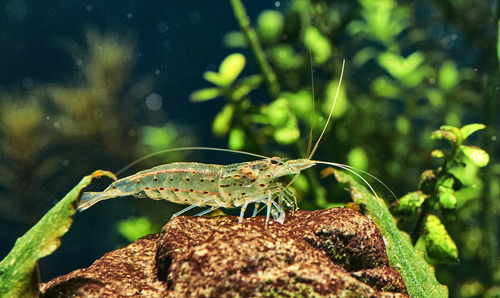
Crayfish make fascinating and entertaining pets. They are relatively easy to care for and can live for several years in captivity. However, to ensure that your pet crayfish stays healthy and happy, it is important to provide it with the right food.
Young Crayfish
When young, crayfish are typically fed on a diet of algae, small aquatic insects, and tadpoles. These foods are high in protein and help the crayfish to grow and develop properly.
Adult Crayfish
As adult crayfish grow larger, their diet changes. They become more carnivorous and will eat a wider range of foods. In captivity, adult crayfish can be fed on a variety of foods including:
- Pellets designed specifically for crayfish
- Shrimp food
- Fish food
- Vegetables such as carrots and zucchini
It is important to ensure that the food you provide is of high quality and free from contaminants. Crayfish are sensitive to pollutants and can become ill if their food is contaminated.
Crawfish
Crawfish, also known as crayfish, are a popular food source in some parts of the world. However, it is important to note that not all crayfish are suitable for human consumption. Some species may contain toxins that can cause illness.
Tadpoles
Tadpoles are a popular food source for young crayfish. However, it is important to ensure that the tadpoles you provide are not carrying any diseases or parasites. Tadpoles can be purchased from pet stores or collected from the wild.
Shrimp Food
Shrimp food is a popular choice for feeding adult crayfish. These foods are designed to provide a balanced diet and are often high in protein. It is important to choose a high-quality shrimp food that is free from contaminants.
Frequently Asked Questions
Intrigued by the enigmatic world of pet crayfish? You’re not alone, and there’s no need to fret. As we explore the depths of crayfish care, we’ve compiled an FAQ guide specifically tailored to answer your burning questions about crayfish.
Now, let’s discuss them.
Is it okay to give my crayfish meal scraps from my other fish?
To make sure your crayfish get the nutrients they need, it’s ideal to give them specialized food. Their nutritional needs might not be satisfied by leftover fish food.
How can I handle a crayfish that won’t eat?
Your crayfish may be exhibiting symptoms of stress or disease if it isn’t eating. Examine your crayfish’s general health and the characteristics of your water, and seek advice from a qualified veterinarian or aquarist if needed.
What are some good options for feeding small aquarium crayfish?
Small aquarium crayfish can be fed a variety of foods, including sinking pellets, frozen or live foods such as bloodworms or brine shrimp, and vegetables such as zucchini or spinach. It is important to provide a balanced diet to ensure proper nutrition.
What types of food should be avoided when feeding crayfish?
Crayfish should not be fed foods that are high in fat, such as beef or pork. They should also not be fed foods that are high in salt or sugar, such as potato chips or candy. It is important to avoid overfeeding, as this can lead to health problems.
What are some suitable tank mates for crayfish?
Crayfish can be aggressive towards other fish and invertebrates, so it is important to choose tank mates carefully. Small, fast-moving fish such as tetras or guppies may be suitable, as well as snails or shrimp. Avoid keeping crayfish with slow-moving or docile fish.
How often should I feed my pet crayfish?
Pet crayfish should be fed once or twice a day, depending on their size and activity level. It is important not to overfeed, as this can lead to health problems. Uneaten food should be removed from the tank to prevent water quality issues.
Can crayfish survive on just algae?
Crayfish are omnivores and require a balanced diet that includes both plant and animal matter. While they may eat algae, it should not be their only food source.
How long can pet crayfish go without food?
Pet crayfish can go several days without food, but it is not recommended to leave them without food for extended periods of time. It is important to provide a balanced diet and to avoid overfeeding.
The Joys of Keeping Crayfish as Pets
Crayfish make for extraordinary pets, offering aquarists an opportunity to immerse themselves in the captivating realm of aquatic life. Whether you are an experienced aquarist or a beginner in the world of aquatic pets, adding a crayfish to your aquarium can bring immense joy, wonder, and a touch of the wild into your home.
By investing time in understanding the dietary needs of crayfish, observing their behavior, and creating an optimal habitat, you can ensure the well-being and happiness of your crayfish companion. Caring for crayfish is a rewarding experience that deepens your appreciation for the delicate harmony of a thriving underwater environment.

As you embark on your journey of keeping crayfish as pets, remember the importance of maintaining water quality, replicating their natural habitat, and striking the perfect balance within your aquarium ecosystem. The addition of a crayfish not only enhances the aesthetic appeal of your aquarium but also offers a connection to the natural world, reminding us of the beauty and diversity that lies beyond our everyday surroundings.
In conclusion, crayfish as pets offer not only a unique and visually pleasing addition to your aquarium but also an opportunity to marvel at the intricate wonders of life. So, whether you are a dedicated aquarist or a beginner in the realm of aquatic pets, consider welcoming a crayfish into your home – they are sure to bring joy, fascination, and a glimpse of the wild into your life.

Ian Sterling, founder of Fishlab.com, began his aquarium journey over 30 years ago, driven by a deep fascination for fish and their diverse personalities. His website, Fishlab.com, is dedicated to making fishkeeping accessible and enjoyable, offering beginner-friendly guidance, expert insights, and a community for aquarists to connect and share experiences.


